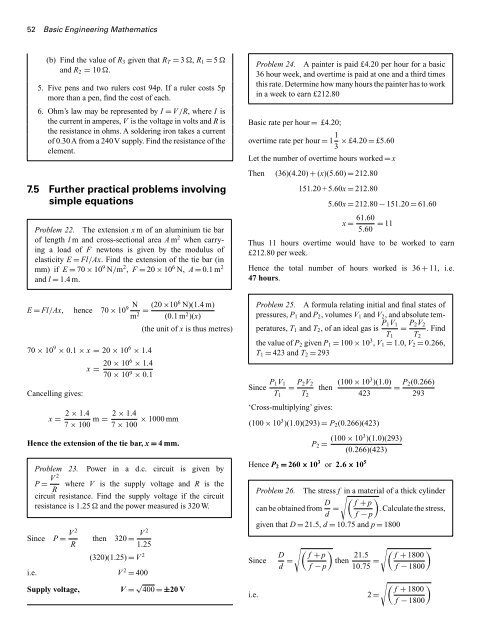basic_engineering_mathematics0
You also want an ePaper? Increase the reach of your titles
YUMPU automatically turns print PDFs into web optimized ePapers that Google loves.
52 Basic Engineering Mathematics<br />
(b) Find the value of R 3 given that R T = 3 , R 1 = 5 <br />
and R 2 = 10 .<br />
5. Five pens and two rulers cost 94p. If a ruler costs 5p<br />
more than a pen, find the cost of each.<br />
6. Ohm’s law may be represented by I = V /R, where I is<br />
the current in amperes, V is the voltage in volts and R is<br />
the resistance in ohms. A soldering iron takes a current<br />
of 0.30A from a 240V supply. Find the resistance of the<br />
element.<br />
7.5 Further practical problems involving<br />
simple equations<br />
Problem 22. The extension x m of an aluminium tie bar<br />
of length l m and cross-sectional area A m 2 when carrying<br />
a load of F newtons is given by the modulus of<br />
elasticity E = Fl/Ax. Find the extension of the tie bar (in<br />
mm) if E = 70 × 10 9 N/m 2 , F = 20 × 10 6 N, A = 0.1m 2<br />
and l = 1.4m.<br />
Problem 24. A painter is paid £4.20 per hour for a <strong>basic</strong><br />
36 hour week, and overtime is paid at one and a third times<br />
this rate. Determine how many hours the painter has to work<br />
in a week to earn £212.80<br />
Basic rate per hour = £4.20;<br />
overtime rate per hour = 1 1 × £4.20 = £5.60<br />
3<br />
Let the number of overtime hours worked = x<br />
Then (36)(4.20) + (x)(5.60) = 212.80<br />
151.20 + 5.60x = 212.80<br />
5.60x = 212.80 − 151.20 = 61.60<br />
x = 61.60<br />
5.60 = 11<br />
Thus 11 hours overtime would have to be worked to earn<br />
£212.80 per week.<br />
Hence the total number of hours worked is 36 + 11, i.e.<br />
47 hours.<br />
E = Fl/Ax, hence 70 × 10 9 N m = (20 ×106 N)(1.4m)<br />
2 (0.1m 2 )(x)<br />
(the unit of x is thus metres)<br />
70 × 10 9 × 0.1 × x = 20 × 10 6 × 1.4<br />
x = 20 × 106 × 1.4<br />
70 × 10 9 × 0.1<br />
Cancelling gives:<br />
x = 2 × 1.4<br />
7 × 100 m = 2 × 1.4 × 1000 mm<br />
7 × 100<br />
Hence the extension of the tie bar, x = 4mm.<br />
Problem 23. Power in a d.c. circuit is given by<br />
P = V 2<br />
where V is the supply voltage and R is the<br />
R<br />
circuit resistance. Find the supply voltage if the circuit<br />
resistance is 1.25 and the power measured is 320 W.<br />
Since P = V 2<br />
R<br />
then 320 = V 2<br />
1.25<br />
(320)(1.25) = V 2<br />
i.e. V 2 = 400<br />
Supply voltage,<br />
V = √ 400 = ±20 V<br />
Problem 25. A formula relating initial and final states of<br />
pressures, P 1 and P 2 , volumes V 1 and V 2 , and absolute temperatures,<br />
T 1 and T 2 , of an ideal gas is P 1V 1<br />
= P 2V 2<br />
. Find<br />
T 1 T 2<br />
the value of P 2 given P 1 = 100 × 10 3 , V 1 = 1.0, V 2 = 0.266,<br />
T 1 = 423 and T 2 = 293<br />
Since P 1V 1<br />
= P 2V 2<br />
then (100 × 103 )(1.0)<br />
= P 2(0.266)<br />
T 1 T 2 423<br />
293<br />
‘Cross-multiplying’ gives:<br />
(100 × 10 3 )(1.0)(293) = P 2 (0.266)(423)<br />
P 2 = (100 × 103 )(1.0)(293)<br />
(0.266)(423)<br />
Hence P 2 = 260 × 10 3 or 2.6 × 10 5<br />
Problem 26. The stress f<br />
√<br />
in a material of a thick cylinder<br />
(<br />
can be obtained from D ) f + p<br />
d = . Calculate the stress,<br />
f − p<br />
given that D = 21.5, d = 10.75 and p = 1800<br />
Since<br />
√ ( )<br />
√ (<br />
D f + p<br />
d = then 21.5<br />
) f + 1800<br />
f − p 10.75 = f − 1800<br />
i.e.<br />
√ ( ) f + 1800<br />
2 =<br />
f − 1800















![[Lonely Planet] Sri Lanka](https://img.yumpu.com/59845622/1/169x260/lonely-planet-sri-lanka.jpg?quality=85)

